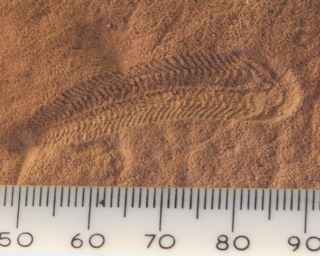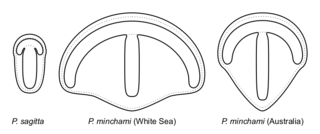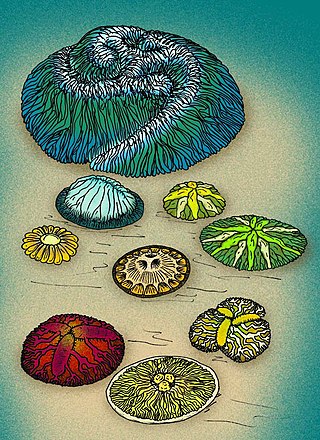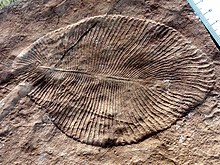
Kimberella is an extinct genus of bilaterian known only from rocks of the Ediacaran period. The slug-like organism fed by scratching the microbial surface on which it dwelt in a manner similar to the gastropods, although its affinity with this group is contentious.

Tribrachidium heraldicum is a tri-radially symmetric fossil animal that lived in the late Ediacaran (Vendian) seas. In life, it was hemispherical in form. T. heraldicum is the best known member of the extinct group Trilobozoa.

Spriggina is a genus of early animals whose relationship to living animals is unclear. Fossils of Spriggina are known from the late Ediacaran period in what is now South Australia. Spriggina floundersi is the official fossil emblem of South Australia; it has been found nowhere else.

Yorgia waggoneri is a discoid Ediacaran organism. It has a low, segmented body consisting of a short wide "head", no appendages, and a long body region, reaching a maximum length of 25 cm (9.8 in). It is classified within the extinct animal phylum Proarticulata.

Cephalonega stepanovi is a fossil organism from Ediacaran deposits of the Arkhangelsk Region, Russia. It was described by Mikhail A. Fedonkin in 1976

Parvancorina is a genus of shield-shaped bilaterally symmetrical fossil animal that lived in the late Ediacaran seafloor. It has some superficial similarities with the Cambrian trilobite-like arthropods.

Trilobozoa is a phylum of extinct, sessile animals that were originally classified into the Cnidaria. The basic body plan of trilobozoans is often a tri-radial or radial sphere-shaped form with lobes radiating from its centre. Fossils of trilobozoans are restricted to marine strata of the Late Ediacaran period.

Praecambridium sigillum is an extinct organism that superficially resembles a segmented trilobite-like arthropod. It was originally described as being a trilobite-like arthropod, though the majority of experts now place it within the Proarticulata as a close relative of the much larger Yorgia. It is from the Late Ediacaran deposit of Ediacara Hills, Australia, about 555 million years ago. On average, P. sigillum had at least 5 pairs of segments, with each unit becoming progressively larger as they approach the cephalon-like head.

Ovatoscutum concentricum is one of many enigmatic organisms known from the Ediacaran deposits of the Flinders Ranges, Australia, and the White Sea area in Russia, dating around 555 Ma.

The Ediacaranbiota is a taxonomic period classification that consists of all life forms that were present on Earth during the Ediacaran Period. These were enigmatic tubular and frond-shaped, mostly sessile, organisms. Trace fossils of these organisms have been found worldwide, and represent the earliest known complex multicellular organisms. The term "Ediacara biota" has received criticism from some scientists due to its alleged inconsistency, arbitrary exclusion of certain fossils, and inability to be precisely defined.

Albumares brunsae is a tri-radially symmetrical fossil animal that lived in the late Ediacaran seafloor. It is a member of the extinct group Trilobozoa.

Proarticulata is a proposed phylum of extinct, near-bilaterally symmetrical animals known from fossils found in the Ediacaran (Vendian) marine deposits, and dates to approximately 567 to 550 million years ago. The name comes from the Greek προ = "before" and Articulata, i.e. prior to animals with true segmentation such as annelids and arthropods. This phylum was established by Mikhail A. Fedonkin in 1985 for such animals as Dickinsonia, Vendia, Cephalonega, Praecambridium and currently many other Proarticulata are described.

Rugoconites is a genus of Ediacaran biota found as fossils in the form of a circular or oval-like impression preserved in high relief, six or more centimeters in diameter. The fossils are surrounded by frills that have been interpreted as sets of tentacles. The bifurcating radial ribs, spreading from a central dome, serve to distinguish this genus from the sponge Palaeophragmodictya, and may represent the channels of the gastrovascular system. Fossils of Rugoconites have been interpreted as early sponges, although this is countered by Sepkoski et al. (2002), who interpreted the organism as a free-swimming jellyfish-like cnidarian; similar to Ovatoscutum. However, the fossil is consistently preserved as a neat circular form and its general morphology does not vary, therefore a benthic and perhaps slow-moving or sessile lifestyle is more likely. Ivantstov & Fedonkin (2002), suggest that Rugoconites may possess tri-radial symmetry and be a member of the Trilobozoa.

Vendiamorpha is a class of extinct animals within the Ediacaran phylum Proarticulata.

Isomer is an element of transverse body articulation of the bilateral fossil animals of the Phylum Proarticulata from the Ediacaran (Vendian) period. This term has been proposed by Andrey Yu. Ivantsov, a Russian paleontologist from the Laboratory of the Precambrian organisms, Paleontological Institute, Russian Academy of Sciences.

Andiva ivantsovi is a Vendian fossil, identified to be a bilaterian triploblastic animal in the Ediacaran phylum Proarticulata, known from the Winter Coast, White Sea, Russia. It was first discovered in 1977, and described as a new species in a new genus by Mikhail Fedonkin in 2002. It lived about 555 million years ago. Fossils of Andiva also occur in South Australia. All known fossils of Andiva are external molds.
Palaeoplatoda is a genus from the Ediacaran biota. It is a soft-bodied organism with a segmented body that resembles Dickinsonia, another Ediacaran organism.

The petalonamids (Petalonamae) are an extinct group of archaic animals typical of the Ediacaran biota, also called frondomorphs, dating from approximately 635 million years ago to 516 million years ago. They are benthic and motionless animals, that have the shape of leaves, fronds (frondomorphic), feathers or spindles and were initially considered algae, octocorals or sea pens. It is now believed that there are no living descendants of the group, which shares a probable relation to the Ediacaran animals known as Vendozoans.

Archaeaspinus fedonkini is an extinct proarticulatan organism from the Late Precambrian (Ediacaran) period.






















